Last Chance to Catch NYC's Holiday Notalgia Train
We met the voices of the NYC subway on our nostalgia ride this weekend!


New York City’s underground subway system is one of the largest in the world, and it is constantly evolving. Since the subway and the city above it have changed so much over the past century, the system is dotted with forgotten entrances and exits that once connected popular stations to nearby buildings or other transit hubs. From an elaborate entrance that once led early 20th-century socialites to a buzzing hotel bar and restaurant to corridors that protected commuters from the elements, discover some of the subway’s forgotten entrances!
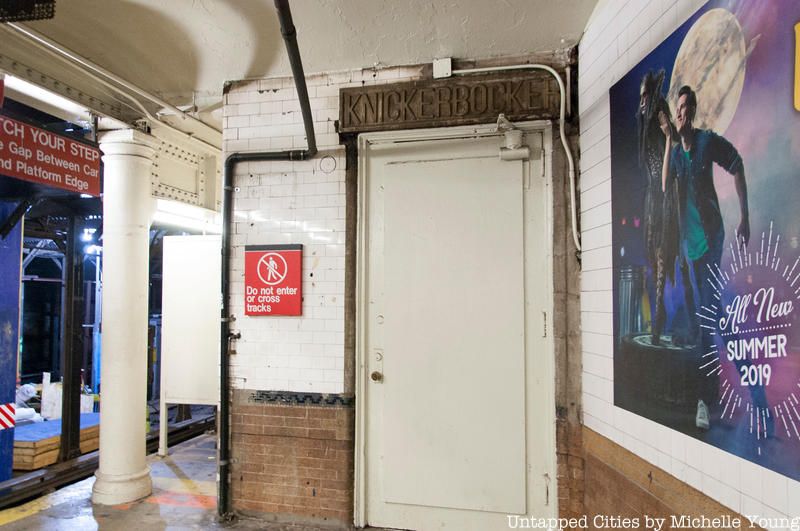
The Times Square subway station is one of the 28 original stations of New York City’s first subway line, the Interborough Rapid Transit, which opened in 1904. The neighborhood where the station is located, formerly known as Longacre Square, was a hub of adult entertainment and prostitution. However, the arrival of the subway, the relocation of The New York Times headquarters, the high-class entertainment of Broadway, and a new name transformed the area.
Wanting to capitalize on the newly minted Times Square’s growing popularity, developers J.E. and A.L. Pennock built a hotel on land owned by John Jacob Astor IV on the southeast corner of 42nd Street and Broadway. The Knickerbocker Hotel opened in 1906 and still exists today. Nicknamed “The 42nd Street Club,” the hotel became a place to see and be seen. Near the shuttle to Grand Central Terminal, at the end of Track 1 in today’s subway station, you can see a door that once led to the hotel’s lowest level, where the bar and restaurant were located. The hallway which leads to the hotel was once decorated with heraldic banners and settees, according to a description from the New York Times in 1906. Today the tunnel is closed from the public and used for storage. Inside, decaying decorative plasterwork and ornate stenciling give hints of its former splendor. The original hotel closed in 1920 and for years the Knickerbocker was used as office space. It was reopened as a hotel in 2015, but the tunnel remains closed.
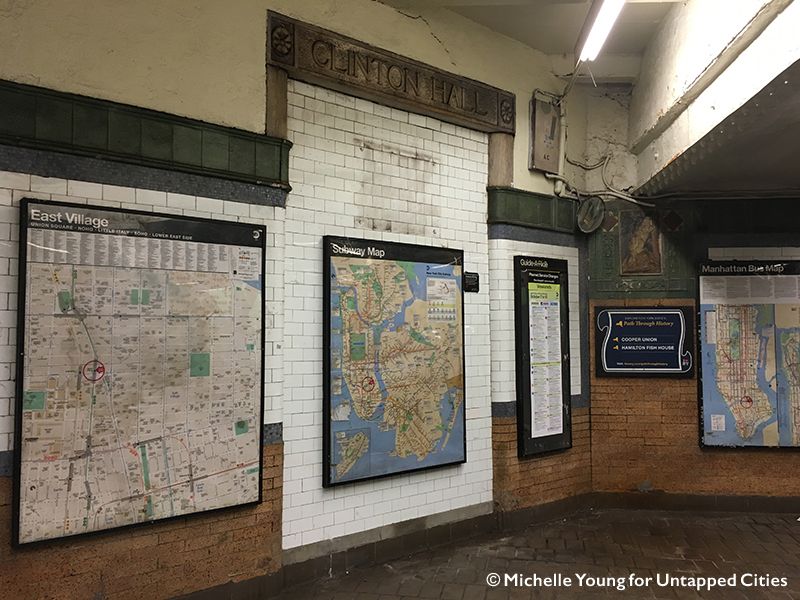
The Astor Place subway station, one of the first original 28 subway stations in New York City, contains many unique features. One can be found just outside the turnstiles on the downtown platform of the 6 train. There, you will find a bricked-up entrance with a sign on top that reads “Clinton Hall.” This often overlooked entryway once led into the Mercantile Library of New York, also known as Clinton Hall. Though the pathway is blocked off, the building is still standing today.

See this forgotten entrance, ride through the oldest stations, uncover hidden art, and more!
⭐ Untapped New York Members at the Insider tier or higher get 50% off!
The Mercantile Library was originally housed inside the Astor Place Opera House which once stood at the triangle of Astor Place on East 8th Street and Lafayette Street. The Library tore down the Opera House in 1890 to construct a new 11-story building to house its growing collection of more than 120,000 volumes. Due to the Library’s significance (it boasted members such as Ralph Waldo Emerson and Mark Twain), a private subway entrance into the building was constructed when the Astor Place subway station was built below it in 1904. The library was relocated in 1932 and today, the Clinton Hall building is condominiums. It is believed that the entrance was bricked-up at some point in the 1940s.
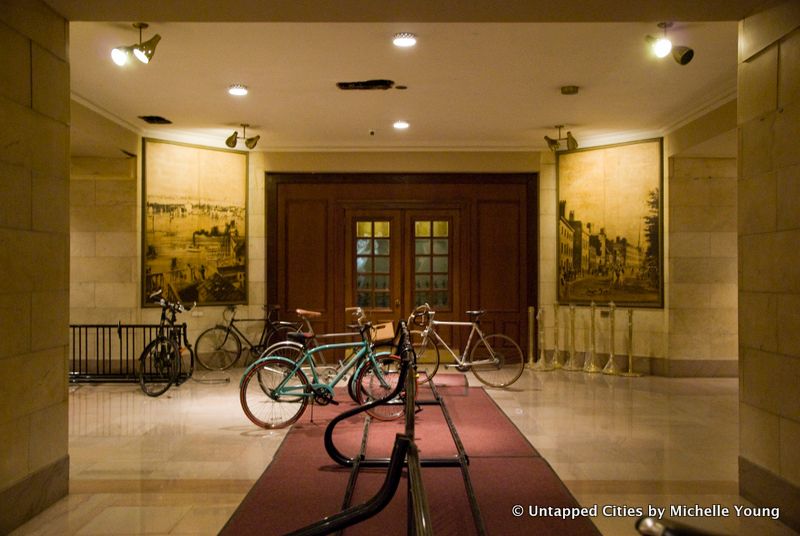
A forgotten entrance to the now-abandoned City Hall Station can be found in the Woolworth Building basement. In the bike room, two large wooden doors mark the entrance to a corridor that Woolworth Building tour guide Jason Crowley says is a “passageway under Broadway to the BMT and IRT subways. The BMT is now the City Hall R stop and the IRT is the now-closed off City Hall stop where the 6 turns around.” The private subway entrance was one of the many amenities the 1913 Woolworth Building offered its tenants. Crowley says that the passageway has since been completely filled in.
Another, smaller, set of doors in the bike hall once led to a passageway under Park Place to the 2/3 stop. Crowley says you can still see the remnants of the entryway in the subway station as well. “If you are in that station where the turnstiles are you can still see the former entrance to the passage with metal bars blocking it,” Crowley notes.
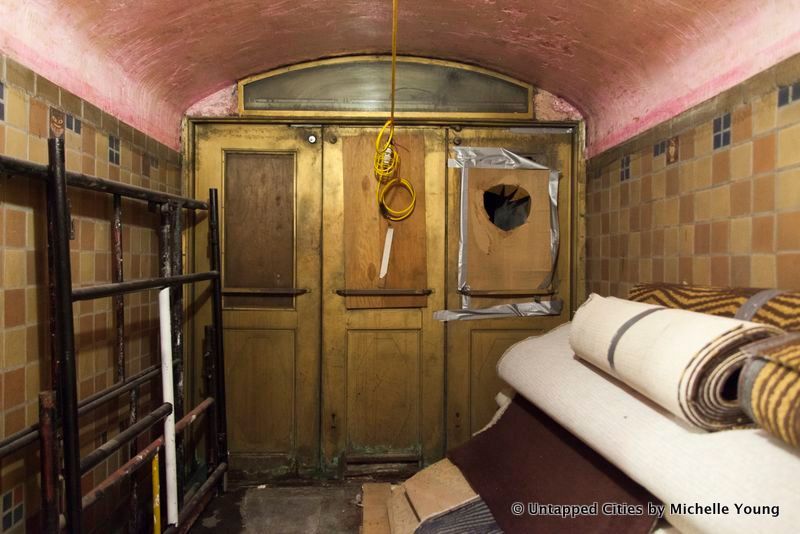
Just like the Woolworth and the Knickerbocker Hotel, the luxurious New Yorker Hotel also had its own entrance to the subway. The now-hidden tunnel once connected Penn Station to an elevator that would take guests up into the hotel. A porter would greet you to take your bags and escort you through the brass doors to the trains. Anticipating the opening of the Eighth Avenue Subway (the A/C/E lines today), the hotel was well situated for guests who needed to use public transit.
The private tunnel was featured in many of the hotel’s advertisements through the 1950s. It was closed in the 1960s and the entrance was sealed with cinderblock. The tunnel is still accessible from inside the hotel and is used for storage. Inside, Art Deco tiling lines the walls.
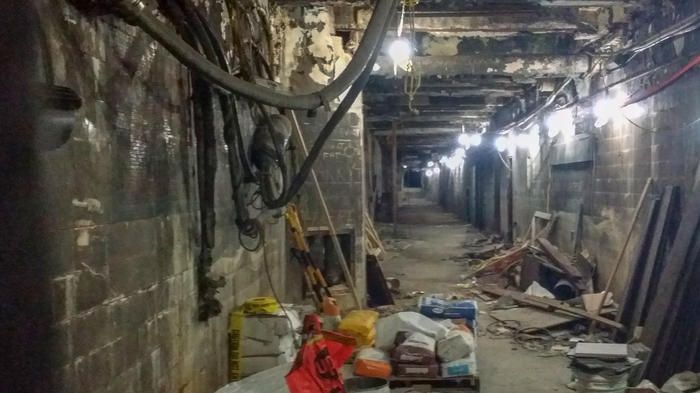
Penn Station has many corridors that once connected the transit hub to nearby destinations such as the New Yorker Hotel and other subway stations. However, after budget cuts in the 1970s, it was difficult to maintain safety and cleanliness within those tunnels. One of Penn Station’s most famous hidden corridors is the Gimbels Passageway which shuttered in the 1980s. The Gimbels Passageway stretched 800 feet under 33rd Street, connecting Penn Station’s 7th Avenue subway lines to the 6th Avenue lines accessible at the Herald Square Station under the former Gimbels Department Store, now the Manhattan Mall.
Entry to the Gimbel’s Passageway is now blocked off in Penn Station. Some improvement plans for Penn Station include widening and re-opening the narrow passageway, but it remains off-limits for now. One convenient passage that does still exist, at least in part, is the Hilton Passageway. The passageway used to connect the 1,2,3 trains in Penn Station to the Hotel Pennsylvania. Today, it serves as a corridor that connects the lower Amtrak concourse, the Long Island Rail Road, and New Jersey Transit to the 1,2,3 trains. Grand Central Terminal also has a complex tunnel system that was built to connect the train terminal to the buildings of Terminal City. While many of the tunnels are blocked off, such as the one that connects to The Roosevelt Hotel, you can see remnants of others, and one was recently re-opened!
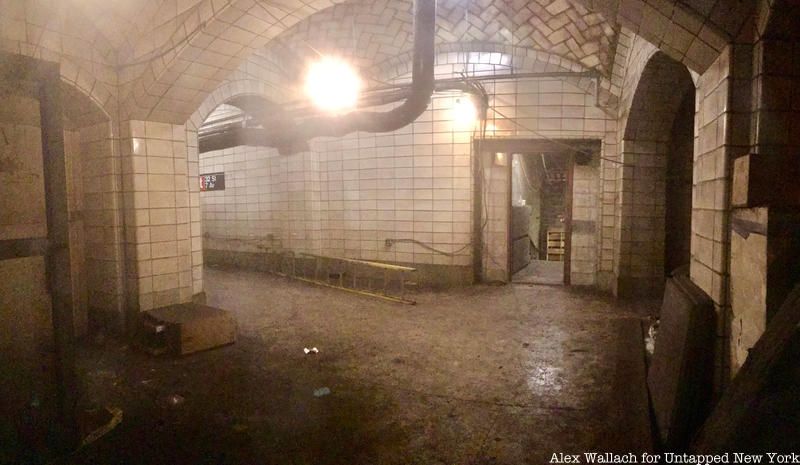
The most recent renovations at Penn Station unveiled many parts of the original 1910 structure designed by McKim, Mead, and White. One piece of the original structure that was temporarily visible in 2019 was a passageway from the LIRR concourse to the IRT or the 1, 2, and 3 trains as we know them today. The corridor is special because it contains Guastavino tiled arches, once a prevalent architectural feature of the original station. According to Maggie Redfern and John Ochsendorf, authors of A Guide to Guastavino in New York City, this is the last example of Guastavino tile work in the entire station.
Amtrak confirmed that the passageway was the “former 32nd Street connection from the downtown 7th Avenue subway into Penn Station on the B Level.” The photo above was taken from where the tunnel would have connected to the 1/2/3 subway. The hallway entrance has been blocked off since the 1980s, and the tunnel is usually dark. It was briefly illuminated so that the MTA could use the tunnel for access during construction. Though it was completely blocked off as of 2021, you can still catch glimpses of Guastavino arches in Penn Station if you know where to look.

See hidden-in-plain-sight pieces of the original Penn on an upcoming tour!
⭐ Untapped New York Members at the Insider tier or higher get 50% off!

There is a now-defunct subway exit behind the main entrance to the Chambers Street subway station at the Municipal Building in Manhattan. There is a grate and standpipe in place of what was likely an exit staircase to one of the now-abandoned platforms of the station below.
Opened in 1913 as part of the Brooklyn Rapid Transit system, the Chambers Street station served as a terminal for trains coming from the Williamsburg and later the Manhattan Bridges. In 1931, two platforms were closed when the Nassau Street subway (now the J/Z lines) opened. The lost staircase may have been removed at that time.
Next, check out 6 Rarely Seen Abandoned NYC Subway Entrances and The Top 20 Secrets of the NYC Subway
Subscribe to our newsletter